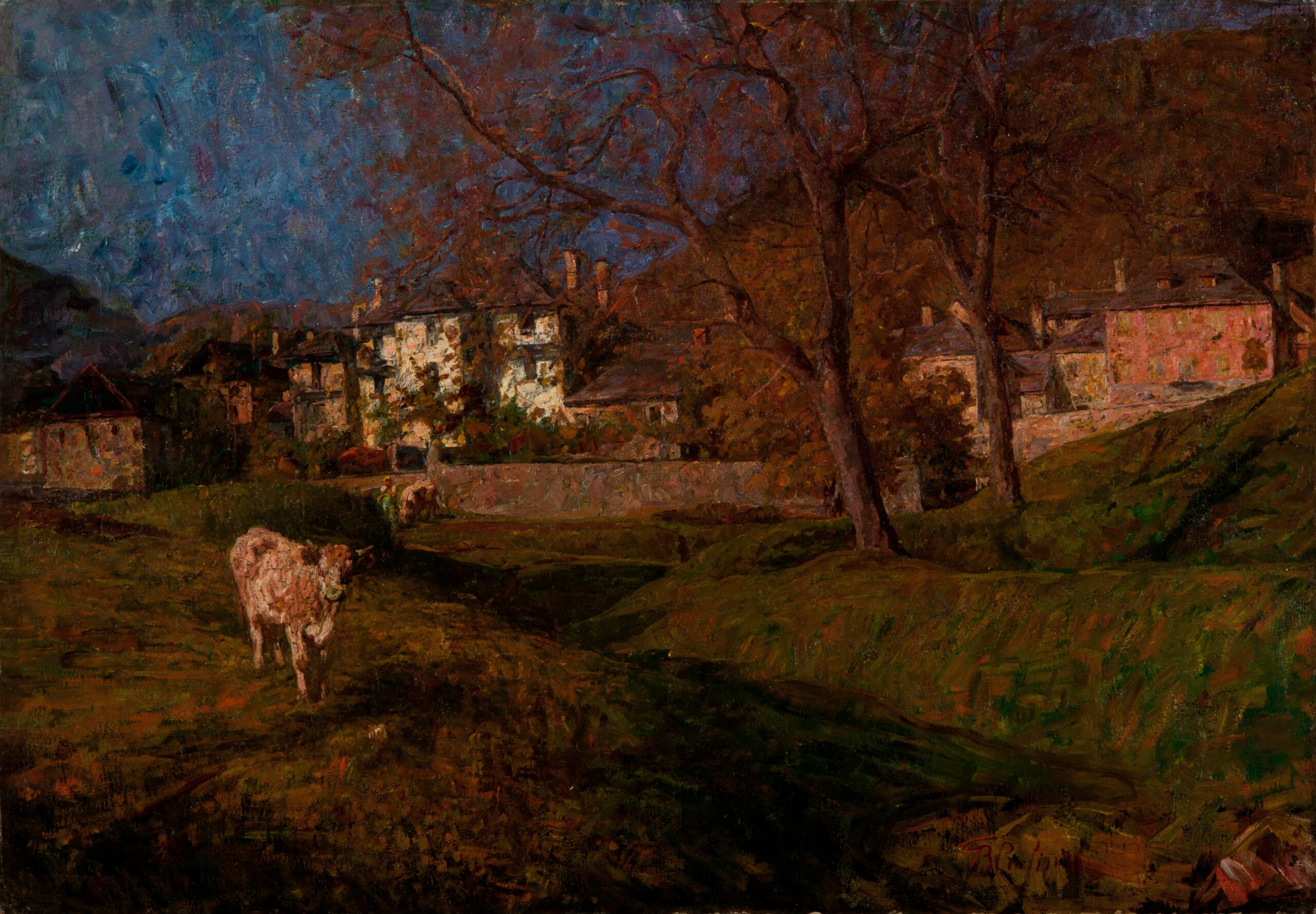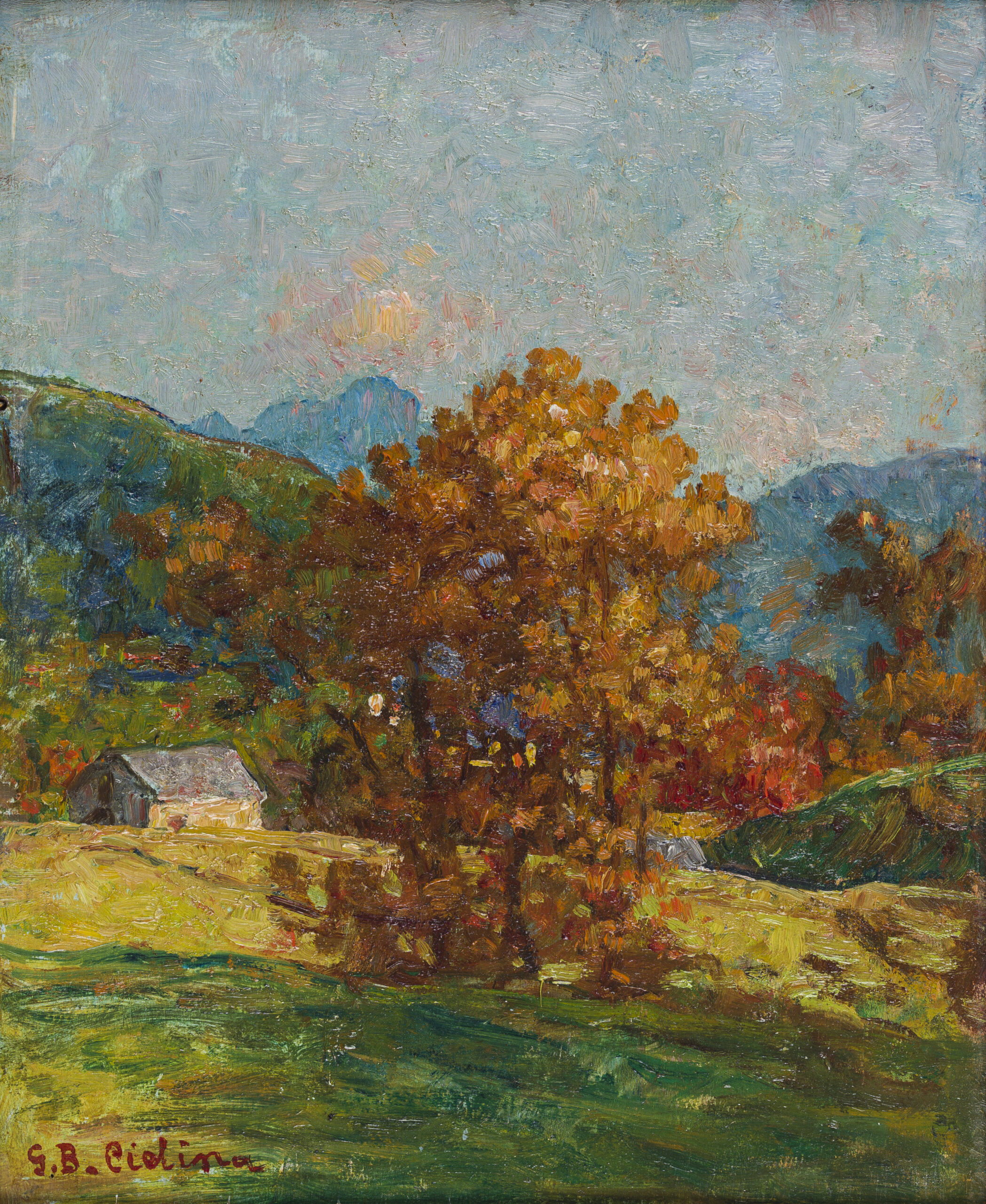After living for some time in a big city environment (…), one comes to love the quiet, solitary small town even more, and all its inhabitants seem to be one big family. How much more preferable is a small town, isolated up high and far from these centres that reek of general corruption (…), where a world of human beings struggles in a thousand ways – some purely for material existence, some for vain ambition, some for glory – in short, in many varied ways according to instinct. (…) How hard it is to live far from one’s homeland, from the domestic home, when your loved ones await you, a wife, and dear, innocent children who remember and call out for you.
May-July 1896. Giovanni Battista Ciolina’s diaries. Transcribed by Paolo Ciolina


CRITICAL ANALYSIS
Toceno al tramonto (Toceno at Sunset) transmits the powerful charm of the warm glow of a fiery sunset that Ciolina achieved by scattering red and brown strokes, across the canvas, using thick, criss-crossing brushstrokes to make the surface vibrate. The domestic subject, a house, modestly hidden behind a tree, and its surroundings are transformed into a poetic vision that conveys more of a feeling than an objective representation of things. On close analysis, and for those familiar with the places, it would be impossible for the last rays of sun to come from the direction that the scene suggests, shaping the sharp shadows in different compositional layers, played on diagonal lines that converge on the right side of the painting. The intense blue of the sky, made even darker by the smudges of purple, pink and green, is certainly not the bright blue that can be seen in reality to the west during an autumn sunset, and that the artist reproduced many times with astonishing effectiveness.
But seeking the objective truthfulness of representation in Ciolina’s work, which in some cases he pursued, would not only be a futile effort but even contradictory to his thoughts, which he clarified perfectly in a page from his diaries in July 1896 when he was with his friend Fornara in Lyon: “For a long time, I had already grasped this free manner: that is, not to copy the truth as it appears to our eyes, nor to insist that a painting be done exclusively and entirely from reality, but rather to use all possible means… as long as the paintings ultimately achieve the right impression.”.
Toceno al tramonto is above all the rendering of an impression; not in the sense that the French Impressionists gave to this term, which neither Cavalli nor his students ever knew, but rather in the sense of a feeling that is awakened and expressed through the evocative subject and the painting style, a style that in Toceno al tramonto certainly reflects Enrico Cavalli’s teaching of the petite tache, technique, the minutely rolled touch of the brush that gives the painted surface a textured, rough feel. This is clearly visible in the pink house on the far right and in some parts of the foliage of the two large trees that dominate the centre of the scene. In most of the painting, we can see intertwining and partially overlapping brushstrokes which are especially evident in the stone walls in pure, albeit non-primary colours. Nonetheless, there are also touches of primary red that are particularly noticeable in the mountain hut on the far left. This technique can be related to a passage from the Lyon diaries where, when commenting on two portraits he was working on, Ciolina wrote: “in the two portraits… I am hinting at a move towards a broader approach, more specifically oriented to the construct of things… I believe this is the right path in art.”. The construct, means the construction of things through a brushstroke that does not follow or reproduce a shape but rather creates it as seen in this masterpiece. At times, the brushstroke becomes entirely autonomous, as in the corner at the bottom right, where the signature stands out. Here, the shape has completely disappeared, leaving only brushstrokes, equipped with unparalleled poetic force. Toceno al tramonto can only have come after the reflections made in Lyon, and it shows the influence of the chromatic approach of the divisionist technique, a technique that was however freely interpreted by a painter as self-assured as Ciolina was in the years around the turn of the century. I would therefore postpone the dating of 1890-1895, suggested by Paolo’s son, by at least three to four years.
The evolution of the construct technique is clearly exemplified in Pomeriggio d’ottobre, (October Afternoon), which Paolo’s son dated to 1950. However, when compared to Il campanile di Crana (The Crana Bell Tower at Sunset – tappa 1), it appears less free, less casual, and still subject to a certain reluctance towards realism. Therefore, it probably precedes it by at least a few years. The view of the valley towards the west features the autumnal tree, partially bathed in light, and the dazzling mountain lodge. They contrast with an interplay of alternating planes of light and shadow that convey the clear freshness of the late September air, still warmed by the sun’s rays that the artist produces in pure red strokes on the slope behind the building and in the tree in the background. Even in the touches of pink on the distant Mount Gridone, and especially in the sky, there is an homage to the Veronese style that Enrico Cavalli held up for his students as one of the highest examples to aspire to.
Text and image research and adaptation by Chiara Besana.
Critical analysis by Paolo Volorio.
Sign up to receive news on events, exhibitions and trainings from the Rossetti Valentini School of Fine Arts Foundation.
Iscriviti per ricevere le news su eventi, mostre, incontri di formazione organizzati dalla Fondazione Scuola di Belle Arti Rossetti Valentini.